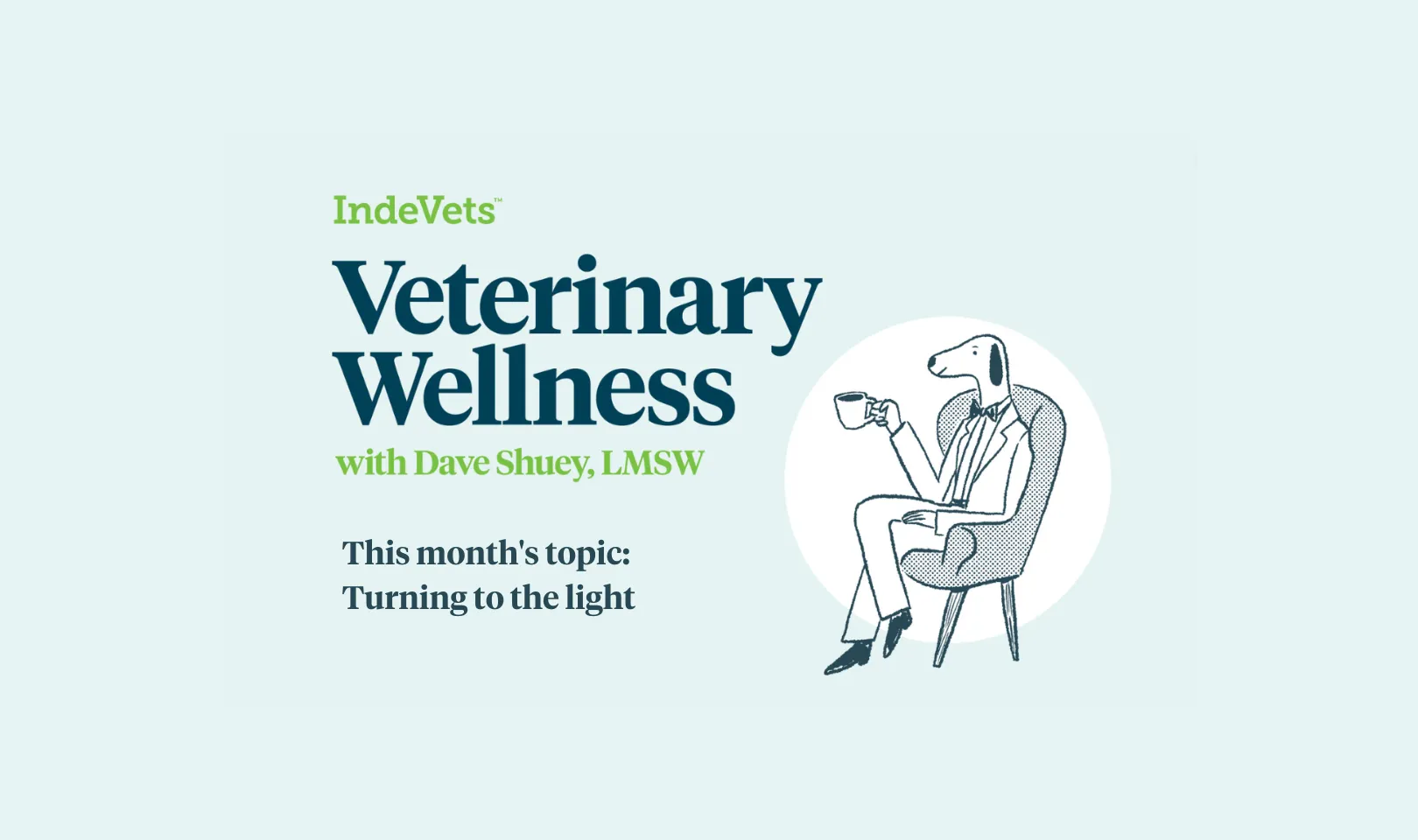Turning Again to the Light


We asked some hard questions in our last Mental Health blog. We acknowledged the dark side of our experience in the practice of vet medicine in the hope of making it mentionable and manageable. Perhaps we sat with some painful feelings. Feelings, like everything else, are subject to change, and this month we can observe the transition from darkness to light. We’ll explore both simple and deep ways to understand and move through our professional duties, discover healthy ways to surf the natural ebb and flow of dark and light, and learn to intentionally move between the darkness and the light for self-care.
I work for a company whose mission is to “To bring balance, fulfillment and joy to veterinary medicine.” I believe these words represent the answer to the three main symptoms of burnout, which are emotional exhaustion, cynicism, and loss of professional efficacy.
Balance, fulfillment, and joy. If you want to risk sounding silly saying that out loud, you’ll discover a natural lilting rhythm to the words. If you repeat the phrase, you’ll find a natural breathing spot on the way from “joy” back to “balance.” It’s as though the phrase is alive. Try it.
Contrast that feeling with the three domains of burnout: exhaustion, cynicism, and loss of professional efficacy. There’s no way to make those words sing or dance. And yet they speak deeply and honestly of our experience. We need them to tell part of the truth about who we are and how we feel, to appreciate the changes that feel good, and to trust that the darkness is temporary.
To illustrate, we’ll briefly discuss the elements of balance, fulfillment, and joy as they dynamically relate to their respective shadows: exhaustion, loss of efficacy, and cynicism.
Balance and Exhaustion
Helping professions such as ours feature high ideals and high stress levels. Let’s hang onto a synonym of balance from science; homeostasis, which means all parts of the system are within acceptable tolerances. We think of homeostasis in our patients all day long: electrolytes, blood sugar, ventilation/perfusion, gait, metabolism, and thousands more indicators of health. Anything that disrupts homeostasis is a stressor. What drives us to exhaustion is the accumulation of time in a physically stressed state, which weakens judgment, amplifies painful emotions and decreases empathy.
Understanding how exhaustion and balance interact with each other means seeing and responding to the stressors of our jobs and stopping working to return balance. This does not only mean taking all our vacation days every year. It also means finding and making time to stop throughout our day. This allows us to get in touch with a rhythmic approach to burning our energy, and we gain a measure of autonomy.
Fulfillment and Inefficacy
I remember from my anesthesia tech days that nothing gave me more confidence and a sense of purpose and belonging than hearing a colleague’s voice from across the prep room announce, “Nice catheter!”: such a simple statement that points to a shared struggle and triumph.
When we feel like our work doesn’t make a positive difference, or we come up against our limitations as human beings and healers, we experience the loss of professional efficacy, a particularly insidious domain of burnout. We feel isolated, lonely, forgotten, devalued. We feel like what we do has no effect on our patients, clients, peers, and profession.
The need for recognition and feeling like our work has value goes far beyond appreciation days/weeks/months or other organizational gestures. Fulfillment is most keenly felt when we connect with each other over things we attach to our own sense of worth. That’s why “bad vein days” can sometimes stay with us longer than we want, and why refusing to accept our limitations in partnership with our colleagues can be crippling.
Fulfillment can be as simple as rolling with the ebb and flow of community and solitude, accepting the bad vein days, and calling out the good catheters. On a deeper level, fulfillment extends to embrace the idea that even if the worst happens, we have done our best and the outcome is outside our ability to control. By acknowledging our limitations, we become able to communicate more honestly and realistically with each other and our clients, and thereby boost our sense of fulfillment through healthy, meaningful connections.
Joy and Cynicism
A recent study found that empathy in helping professions can be measured along at least two pathways: appreciating what has happened to a person or animal, or actually “feeling what they feel,” the latter being the more popular definition of empathy in the helping professions. It turns out that “feeling what they feel” triggers the involuntary stress response, leading to the very cynicism we fear. We also notice it in negative or judgmental thoughts we have for clients who we perceive to be falling short of delivering ideal care for their pets, which can lead to cultural cynicism. A certain emotional detachment, however, can be protective and lead to more effective helping behavior and a deeper sense of efficacy. You might say that being dispassionate now and then is a path to joy.
Another path to joy is simply noticing when things are relatively OK and saying something grateful about it. Equally important to honestly facing the reality of our pain is honestly admitting it when “within normal limits” is actually quite nice. One of our favorite adjectives in anesthesia was “boring.” The saying goes, “boring anesthesia is good anesthesia.” That’s how we could easily and concisely convey our contentment with the situation, our sense of connection with the flow of care regardless of the outcome, and ultimately our joy.
So maybe the changes from light to dark and back again cannot be linear, constant, or goal-oriented but are by nature orbital, rhythmic, and dynamic. The choice of terms like balance, fulfillment, and joy is an answer to the shadow realities of exhaustion, inefficacy, and cynicism. Altogether, they make up a world of experience that allows growth to continue, connections to multiply, meaning to evolve, and gratitude to flourish.
Things to try:
- To practice balance, find the time to stop working, be it for five minutes or for two weeks or longer. Music is the silence between the notes.
- To practice fulfillment, advocate out loud for a colleague’s work, and cultivate an attitude of respect for limitations, and realize that we are all doing the best we can.
- To practice joy, recognize and declare when things are “within normal limits” and that’s really pretty good.
What else can you think of to practice balance, fulfillment and joy?
Further reading
Buffone, A., Poilin, M., DeLury, S., Ministero, L., Morrisson, C., & Scalco, M. (2017). Don’t walk in her shoes! Different forms of perspective taking affect stress physiology. Journal of Experimental Social Psychology, 72(2017), 161-168. DOI: 10/1016/jesp.2017.04.001.
